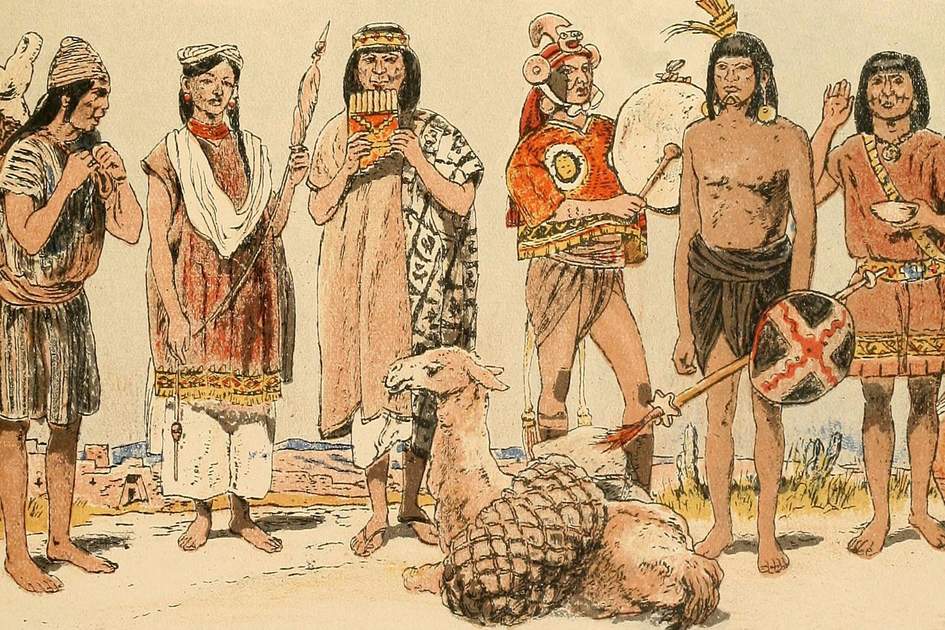
The Inca Empire was founded in the early 13th century by the legendary leader Manco Capac. According to legend, Manco Capac was sent by the sun god Inti to establish a new civilization in the Andes Mountains. The early Incas were a small tribe that gradually expanded their territory through warfare and diplomacy. Over time, they established a highly organized society that was known for its impressive infrastructure, art, and military might.
At its peak, the Inca Empire stretched over 4,000 kilometers from modern-day Ecuador to Chile. This vast territory encompassed a wide range of geographic features, from coastal deserts to high mountain peaks. The Inca Empire was incredibly diverse, with over 100 different languages spoken throughout its territory. Despite this diversity, the Incas were able to maintain a unified empire through their highly organized system of government and social hierarchy.
The capital city of the Inca Empire was Cusco, which is located in modern-day Peru. Cusco was the political, economic, and cultural center of the Inca Empire. It was known for its impressive architecture, including the famous Sacsayhuaman fortress and the Temple of the Sun. Cusco was also home to the Inca’s royal palace, where the Sapa Inca and his family lived.
The Inca Empire had a population of approximately 12 million people. This made it one of the largest empires in the world at the time. Despite its large size, the Inca Empire had a highly centralized government, which allowed for efficient communication and coordination. The Incas were able to maintain control over their vast empire through a combination of military might, diplomacy, and strategic alliances with other tribes and kingdoms.
The Inca Empire was ruled by a single emperor, known as the Sapa Inca. The Sapa Inca was considered to be a god on earth and was believed to have the power to control the weather and the crops. The Sapa Inca was also responsible for overseeing the empire’s complex system of government, which included regional governors, tax collectors, and military commanders.
The Inca Empire had a complex system of roads, which spanned over 40,000 kilometers. These roads connected the various regions of the empire and allowed for efficient communication and transportation of goods and people. The Inca roads were built to be incredibly durable, with many still in use today. They were constructed using a combination of stone and earth and were designed to withstand earthquakes and other natural disasters.
The Inca Empire did not have a writing system, so much of what we know about them comes from oral tradition and Spanish accounts. The Incas used a system of knotted strings called quipus to keep track of important information, such as census data and tax records. While the quipus were not a true writing system, they were incredibly sophisticated and allowed the Incas to maintain a complex system of accounting and administration.
The Inca Empire had a highly organized system of government and social hierarchy. At the top of the social hierarchy was the Sapa Inca, followed by the nobility and the army commanders. Below them were the common people, who were divided into groups based on their occupation and social status. The Incas also had a system of slavery, although it was much more limited than in other empires of the time.
The Inca Empire had a unique form of accounting using a system of knotted strings called quipus. The quipus were made of strings of different colors and thicknesses, with knots tied at various intervals. Each knot and color represented a different piece of information, such as numbers, quantities, and events. The Incas used quipus to keep track of everything from census data to crop yields to tribute payments. The system was highly effective and allowed the Incas to maintain a complex system of administration and taxation.
The Incas were skilled farmers who were able to cultivate crops in the high-altitude Andes Mountains. They developed a system of terraced agriculture, which involved carving out flat areas on the sides of mountains and filling them with fertile soil. The Incas grew a wide range of crops, including maize, potatoes, quinoa, and beans. They were also skilled at irrigation and developed a system of canals and aqueducts to bring water to their crops.
The Incas were known for their impressive architecture, which included massive stone structures and intricate carvings. They used a technique called ashlar masonry, which involved fitting together stones so tightly that no mortar was needed. Some of the most impressive Inca structures include the fortress of Sacsayhuaman, the Temple of the Sun in Cusco, and the Machu Picchu citadel.
The Incas were skilled metalworkers who created intricate objects using gold, silver, and copper. They developed a technique called tumbaga, which involved mixing gold with other metals to create alloys of varying colors and hardness. The Incas created a wide range of objects, from jewelry and ceremonial objects to weapons and tools.
The Inca Empire had a highly organized system of tribute and taxation. Each region of the empire was required to pay tribute in the form of goods or labor. The Incas also had a complex system of taxation, which included a labor tax, a harvest tax, and a tax on goods. Despite the high level of taxation, the Incas were able to maintain a relatively equal distribution of wealth throughout their empire.
The Inca Empire was a theocracy, with religion playing a central role in daily life. The Incas worshipped a wide range of gods, including the sun god Inti and the earth goddess Pachamama. They believed that the Sapa Inca was a direct descendant of the sun god and that he had the power to communicate with the gods. The Incas also practiced human sacrifice on occasion, although it was much less common than in other pre-Columbian civilizations.
The Inca Empire was conquered by the Spanish in the 16th century. The Spanish, led by Francisco Pizarro, arrived in South America in 1532 and began their conquest of the Inca Empire. They were able to defeat the Incas through a combination of superior weaponry, military strategy, and disease. The conquest of the Inca Empire led to the destruction of much of its cultural heritage and the forced conversion of many of its people to Christianity.
Machu Picchu is one of the most famous Inca sites, located in modern-day Peru. It was built in the 15th century and was likely a royal retreat for the Sapa Inca and his family. The site was abandoned after the Spanish conquest and was not rediscovered until 1911. Today, Machu Picchu is a popular tourist destination and a UNESCO World Heritage site.
The Incas were skilled weavers who created intricate textiles using llama and alpaca wool. They used a technique called backstrap weaving, which involved tying one end of the loom to a stationary object and the other end to a strap that was tied around the weaver’s waist. The Incas created a wide range of textiles, including clothing, blankets, and tapestries.
The Incas had a highly developed system of medicine, which included the use of plants and herbs to treat a wide range of ailments. They also practiced surgery and had knowledge of anatomy. The Incas believed in the power of the gods to heal and often combined medical treatments with religious rituals. They also had a system of public health that included sanitation and hygiene practices.
The Incas were skilled astronomers who developed a sophisticated system for observing the movements of the stars and planets. They used a system of observatories and had a detailed understanding of the movements of celestial bodies. The Incas also used astronomy for religious purposes, believing that the stars and planets were connected to the gods.
The Inca Empire had a system of roads that stretched for thousands of miles throughout the Andes Mountains. The roads were used for transportation and communication, and allowed the Incas to maintain control over their vast empire. The roads were built using a combination of labor and engineering skills, and were able to withstand earthquakes and other natural disasters.
The Incas had a complex system of social organization, with individuals assigned to different roles based on their gender and birth status. The Sapa Inca was at the top of the social hierarchy, followed by the nobility, the commoners, and the slaves. The Incas also had a system of compulsory labor, known as the mit’a, which required all able-bodied men to work for the empire for a set period of time each year.
The Incas had a unique system of writing called quipu, which involved tying knots in a series of cords to represent numerical data. The quipu was used for a wide range of information, such as census data, crop yields, and tribute payments. The system was highly effective and allowed the Incas to maintain a complex system of administration and taxation.
The Incas were skilled in the art of war and were able to conquer a vast empire through a combination of military strategy and diplomacy. They had a highly organized military, with soldiers assigned to different units based on their experience and skill level. The Incas also used psychological warfare, such as displaying their military strength and staging mock battles, to intimidate their enemies.
The Incas had a complex system of religion and belief in the afterlife. They believed in a system of reincarnation, where the soul of the deceased would be reborn into a new body. The Incas also believed in the power of the gods and had a highly developed system of religious rituals and ceremonies.
The Inca Empire was one of the largest and most powerful civilizations in the Americas prior to the arrival of the Spanish. Its achievements in architecture, agriculture, engineering, and astronomy continue to inspire people around the world. The legacy of the Incas can still be seen in the ruins of their great cities, the textiles and ceramics they created, and the enduring traditions of the Andean people.
Frequently Asked Questions about the Incas
1. Who were the Incas?
The Incas were a civilization that thrived in the Andes Mountains of South America between the 13th and 16th centuries. They built the largest empire in pre-Columbian America, with a population estimated to be between 6 and 14 million people.
2. Where did the Inca civilization originate?
The Incas originated in the village of Paqari-tampu, about 15 miles (24 km) south of Cuzco, in modern-day Peru. According to their legends, the founder of the Inca dynasty, Manco Capac, led the tribe to settle in Cuzco, which became their capital.
3. What was the capital city of the Inca Empire?
The capital of the Inca Empire was Cuzco, located in modern-day Peru. It was a major urban center with impressive architecture, including palaces, temples, and fortifications.
4. How was the Inca Empire organized in terms of leadership and governance?
The Inca Empire was a highly centralized state ruled by the Sapa Inca, who was considered a divine ruler, a descendant of the sun god Inti. The emperor ruled with the aid of an aristocratic bureaucracy, exercising authority with harsh and often repressive controls. The empire was divided into four regions, each governed by an apo, or governor.
5. What innovations and achievements are the Inca people known for?
The Incas are known for their impressive achievements in various fields, including:
- Engineering: The Incas were skilled engineers who built an extensive network of roads, bridges, and tunnels throughout their empire. They also developed sophisticated irrigation systems and agricultural terraces to cultivate the steep mountainsides of the Andes.
- Architecture: The Incas were master builders who constructed impressive stone structures, such as Machu Picchu, a mountaintop citadel that is now a UNESCO World Heritage Site. Their buildings were often made of precisely cut stones that fit together without the need for mortar.
- Agriculture: The Incas were skilled farmers who cultivated a variety of crops, including potatoes, maize, quinoa, and coca. They developed innovative agricultural techniques, such as terrace farming and irrigation, to maximize crop yields in the challenging Andean environment.
- Communication: The Incas developed a unique system of knotted strings called quipus to record numerical and possibly narrative information. Although the exact meaning of the quipus is still debated, they were clearly an important tool for communication and record-keeping.
6. How did the Inca Empire expand its territory?
The Inca Empire expanded through a combination of conquest and diplomacy. The Incas were skilled warriors, but they also sought to incorporate conquered peoples into their empire peacefully. They often offered conquered leaders positions of power within the empire in exchange for their loyalty.
7. What role did religion play in Inca society?
Religion was central to Inca society. The Incas worshipped a pantheon of gods, with the sun god Inti as the most important. They believed that the Sapa Inca was a descendant of Inti and therefore had divine authority. The Incas built temples and shrines to honor their gods and performed elaborate rituals, including human sacrifice, to appease them.
8. What were some of the major agricultural practices of the Inca people?
The Incas were skilled farmers who developed a variety of agricultural techniques to cultivate the challenging Andean environment. Some of their major agricultural practices included:
- Terrace farming: The Incas built terraces into the steep hillsides of the Andes to create flat areas for farming. This also helped to prevent soil erosion and conserve water.
- Irrigation: The Incas developed sophisticated irrigation systems to bring water to their crops. They built canals and aqueducts to divert water from rivers and springs to their fields.
- Crop rotation: The Incas practiced crop rotation to maintain soil fertility. They would plant different crops in the same field in different years to prevent the soil from becoming depleted.
- Fertilization: The Incas used a variety of fertilizers, including llama manure and guano (bird droppings), to enrich the soil.
9. How did the Inca people use quipus, and what were they?
Quipus were a system of knotted strings used by the Incas to record numerical and possibly narrative information. The knots were tied in different colors and patterns, and their position on the strings represented different values. Although the exact meaning of the quipus is still debated, they were clearly an important tool for communication and record-keeping.
10. What led to the decline and fall of the Inca Empire?
The Inca Empire was already weakened by internal rebellions and disease when the Spanish conquistadors arrived in the 16th century. The Spanish, led by Francisco Pizarro, captured the Sapa Inca Atahualpa in 1532 and eventually conquered the Inca Empire. The Spanish conquest marked the end of the Inca Empire and the beginning of Spanish colonial rule in Peru.
11. What is the legacy of the Incas?
The Incas left a lasting legacy in the Andes Mountains. Their descendants, the Quechua people, continue to live in the region and maintain many of their traditions. The Incas’ impressive architectural achievements, such as Machu Picchu, are a testament to their ingenuity and skill. Their agricultural innovations, such as terrace farming, are still used in the Andes today. The Incas’ legacy continues to inspire and fascinate people around the world.
12. Where can I learn more about the Incas?
There are many resources available to learn more about the Incas, including books, websites, museums, and documentaries. Some recommended resources include:
- Books:
- “The Incas” by Terence N. D’Altroy
- “Lost City of the Incas” by Hiram Bingham
- “The Incas: New Perspectives” by Gordon McEwan
- Websites:
- World History Encyclopedia: https://www.britannica.com/topic/Inca
- Britannica: https://www.britannica.com/topic/Inca
- National Geographic: https://www.history.com/topics/latin-america/machu-picchu
- Museums:
- Museo Larco, Lima, Peru
- Museo de Arte Precolombino, Cusco, Peru
- National Museum of the American Indian, Washington, D.C.
- Documentaries:
- “Lost City of the Incas” (PBS)
- “The Incas” (BBC)
- “Machu Picchu: Secrets of the Incas” (National Geographic)









